Originally published at Project-Syndicate | October 31, 2020
MILAN/STANFORD – In late July, opinion polls clearly indicated that US President Donald Trump had lost ground to Joe Biden, his Democratic challenger in the upcoming presidential election, owing primarily to his administration’s mismanagement of the COVID-19 pandemic. Since then, Trump’s fortunes have not improved; if anything, they have deteriorated further. Now, Trump appears set not only to lose the popular vote on November 3, but also to fail to pull off an Electoral College upset, as he did in 2016.
Start with party affiliations. As Table 1 shows, since the 2016 election, the Democratic Party’s ranks have grown by 6%, compared to just under 3% for Republicans. Self-identified independents declined by 8%. Among those who still identify as independents, the share of those leaning either left or right has changed little.
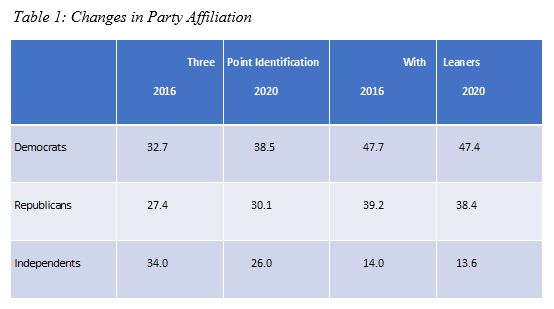
Moreover, as Table 2 shows, perceptions of Trump’s management of the COVID-19 crisis have declined considerably since March, and even since July, especially among moderate Republicans, Democrats, and independents – three groups whose votes are decisive in battleground states. Trump’s overall approval rating has also declined, though not quite as much.
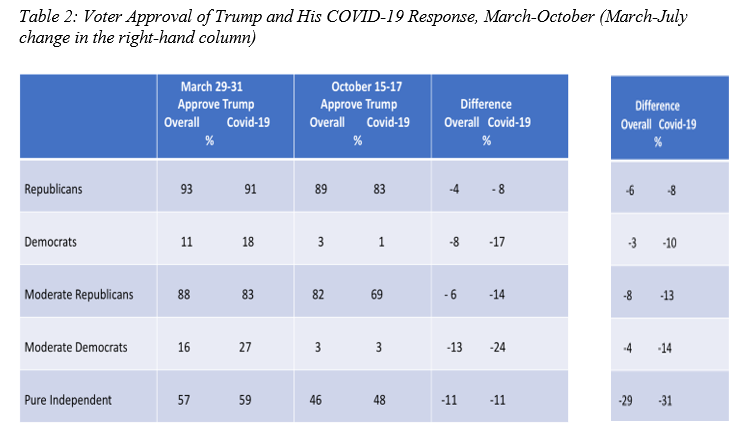
Regression analysis – using a wide array of known variables that are correlated with voting behavior, including party affiliation and ideology – supports the assumption that the COVID-19 crisis is a major driver of this shift. This includes both the pandemic itself and the economic and employment crisis that it has caused.
To be sure, ongoing protests against systemic racism and police brutality – which have often been met with excessive force by police – are also capturing American voters’ attention. But the way in which those protests are interpreted – that is, whether voters believe they are violent and require a strong “law-and-order” response – is overwhelmingly consistent along party lines, and thus unlikely to affect voting decisions significantly.
As Table 3, which uses data from October YouGov polls, shows, only 15% of Democrats believe the protests are violent. Of those, 19% – just 2.85% of all Democrats – may vote for Trump because of the protest issue.
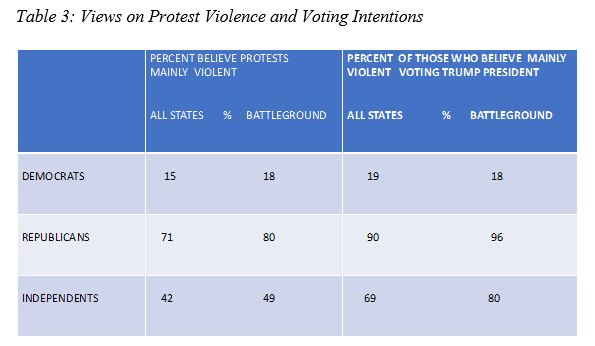
Overwhelmingly, Democrats still have no intention of voting for Trump, regardless of whether they identify as ultra-liberal, moderate, or anything in between. On the contrary, as Table 4 shows, even fewer plan to vote for Trump than the very few who were considering doing so in July, and even more plan to vote for Biden.
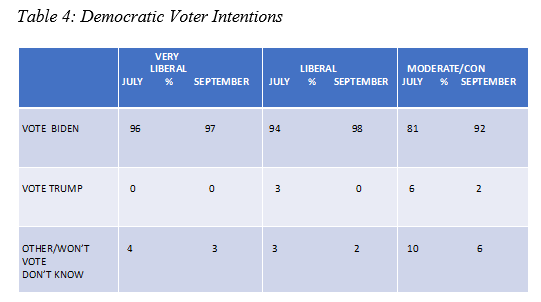
In 2016, support for Trump’s then-Democratic challenger, Hillary Clinton, was lower across all three categories of Democratic voter, especially among moderate and conservative Democrats (81%), than it is for Biden today. Since these data were collected in mid-October, when many people were already casting their ballots, there is little reason to think that the protests or anything else will increase Democratic support for Trump.
Biden is doing better than Clinton not only among Democrats, but among all voters. In 2016, Clinton won the popular vote by 2.1%, but lost in key battleground states, resulting in her defeat in the Electoral College. As Table 5 shows, the vast majority of those who voted for Clinton in 2016 intend to vote for Biden this year.
But Biden’s advantage is much larger. While most of Trump’s 2016 supporters also plan to vote for him again, he has lost more voters than the Democrats have. Add to that the fact that Clinton voters were already the larger group, and Biden’s lead among these two groups of voters reaches the 8% range. Third-party voters from 2016 are also more likely to prefer Biden over Trump this year.
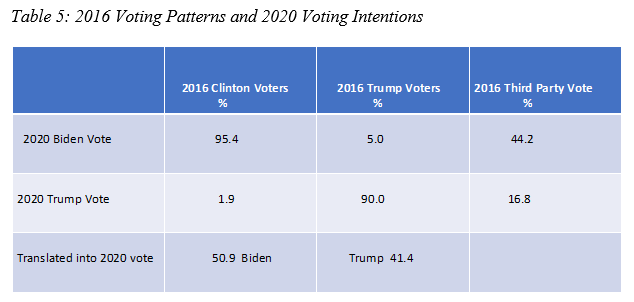
Biden’s advantage extends to the battleground states. Though the difference is somewhat smaller, the Democrats have retained more voters from 2016 than Trump has, and more third-party voters plan to vote for Biden than for Trump.
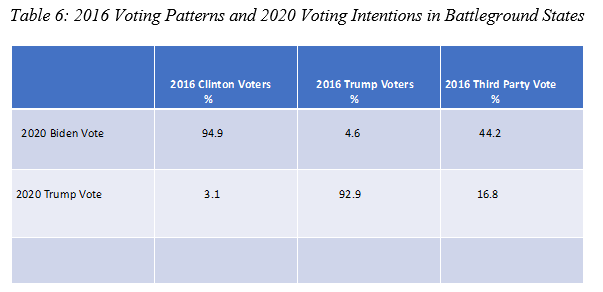
A demographic breakdown of the voting public, as shown in Table 7, further reinforces the impression that Biden will come out ahead. Among every category of voter – young and old, female and male, non-white and white, more and less educated – Biden is doing better than Clinton was in 2016.
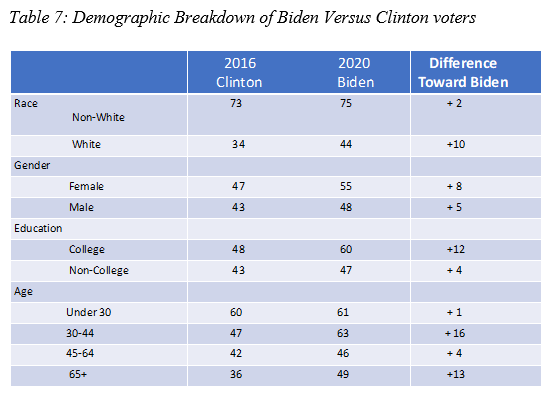
Of course, voting intentions matter little, if people cannot actually manage to vote. And this election is occurring amid a pandemic, which limits traditional voting methods. But, as Table 8 shows, far more voters – especially Democrats and independents, but also Republicans – are embracing early voting and voting by mail.
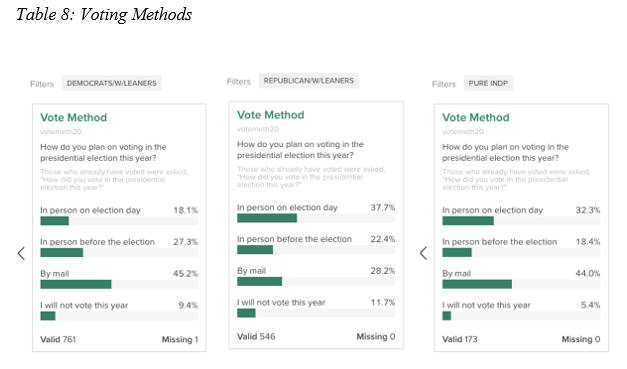
This could have implications for the election results – or, at least, how they are received. Issues arising from vote-by-mail systems, or even a protracted ballot-counting process, could fuel state-level challenges to the results. Because Biden is likely to receive more mailed-in votes, he is more vulnerable to such challenges, which, if successful, could significantly alter the picture painted by the polling data. The United States may face a period of volatility as it awaits results.
Nonetheless, if the polls are a reasonably accurate indication, Biden is on track to win the popular vote by a substantial margin, and an Electoral College reversal of that outcome is unlikely. Trump’s hardcore base is simply not large enough to hand him victory, and he lacks the support of moderates and independents. Biden could suffer due to fragmentation within the Democratic Party – say, if progressive voters decide not to support him – but the polls show no evidence of this. The desire to vote Trump out seems to be too great.
Of course, the polls have been wrong before, including in 2016. The intentions of key groups of voters on either side may not be accurately reflected in the results. In fact, when YouGov asked voters whether their neighbors would be surprised by their voting intentions, about 10% of urban and rural voters said “yes,” indicating that there may be “hidden” voters for both candidates.
In short, Biden looks like he is headed to the White House. But the race isn’t over until it is over.
Michael Spence: a Nobel laureate in economics, is Professor of Economics Emeritus and a former dean of the Graduate School of Business at Stanford University. He is Senior Fellow at the Hoover Institution, serves on the Academic Committee at Luohan Academy, and co-chairs the Advisory Board of the Asia Global Institute. He was chairman of the independent Commission on Growth and Development, an international body that from 2006-10 analyzed opportunities for global economic growth, and is the author of The Next Convergence: The Future of Economic Growth in a Multispeed World.
David W. Brady: Professor of Political Science and Leadership Values at Stanford University and Senior Fellow at the Hoover Institution.



